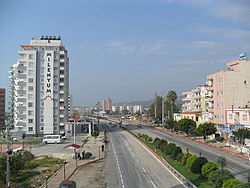Limonlu
|
Limonlu (Lamas) |
|
|---|---|
| Town | |
 |
|
| Location in Turkey | |
| Coordinates: 36°33′N 34°14′E / 36.550°N 34.233°ECoordinates: 36°33′N 34°14′E / 36.550°N 34.233°E | |
| Country |
|
| Province | Mersin Province |
| District | Erdemli |
| Elevation | 5 m (16 ft) |
| Population (2012) | |
| • Total | 3,475 |
| Time zone | EET (UTC+2) |
| • Summer (DST) | EEST (UTC+3) |
| Postal code | 33770 |
| Area code(s) | 0324 |
| Licence plate | 33 |
Limonlu (ancient: Antiochia Lamotidos; Byzantine: Lamousia; Arabic: Lāmis; Armenian: Lamos) is small town in Mersin Province, Turkey (Popularly called Lamas).
Limonlu is a coastal town at 36°33′N 34°14′E / 36.550°N 34.233°E It is by the river Limonlu. It is a part of Erdemli district of Mersin Province. Highway distances to selected localities are as follows: 9 kilometres (5.6 mi) to Erdemli 38 kilometres (24 mi) to Silifke (another district center in Mersin Province) and 45 kilometres (28 mi) to Mersin. The settled (winter) population was 3475 as of 2012.
In antiquity the Limonlu River was the boundary between Cilicia Pedias and Cilicia Trachea, making Limonlu an important border town. In the 10th century A.D. it was a Greek frontier post where prisoners of war were exchanged with the Arabs who controlled Cilicia Pedias. The Byzantine Emperor Manuel I Komnenos captured the town from the Armenians in 1158, but lost it shortly thereafter to the Armenian Kingdom of Cilicia. In the 1160s Vasak, the brother of the Armenian Baron of Papeŕōn (Çandır Castle), is listed in the Chronicle of Smbat as the lord of Lamas Castle. The Armenians maintained possession of this strategic site until the 14th-century invasion of the Karamanids. The Ottomans captured the town and its fortress in the late 15th century.
The ruins of the castle are 1 kilometer (0.62 mi) north of the town and consist of a very symmetrical oval wall and at least five towers. At the west end a large fortified wall with a square bastion is placed inside the circuit wall. Most of the fort’s masonry consists of spolia taken from the nearby late antique city and necropolis. Because of its peculiar plan, masonry, and techniques of construction, it is highly likely that this is a Byzantine castle.
...
Wikipedia

